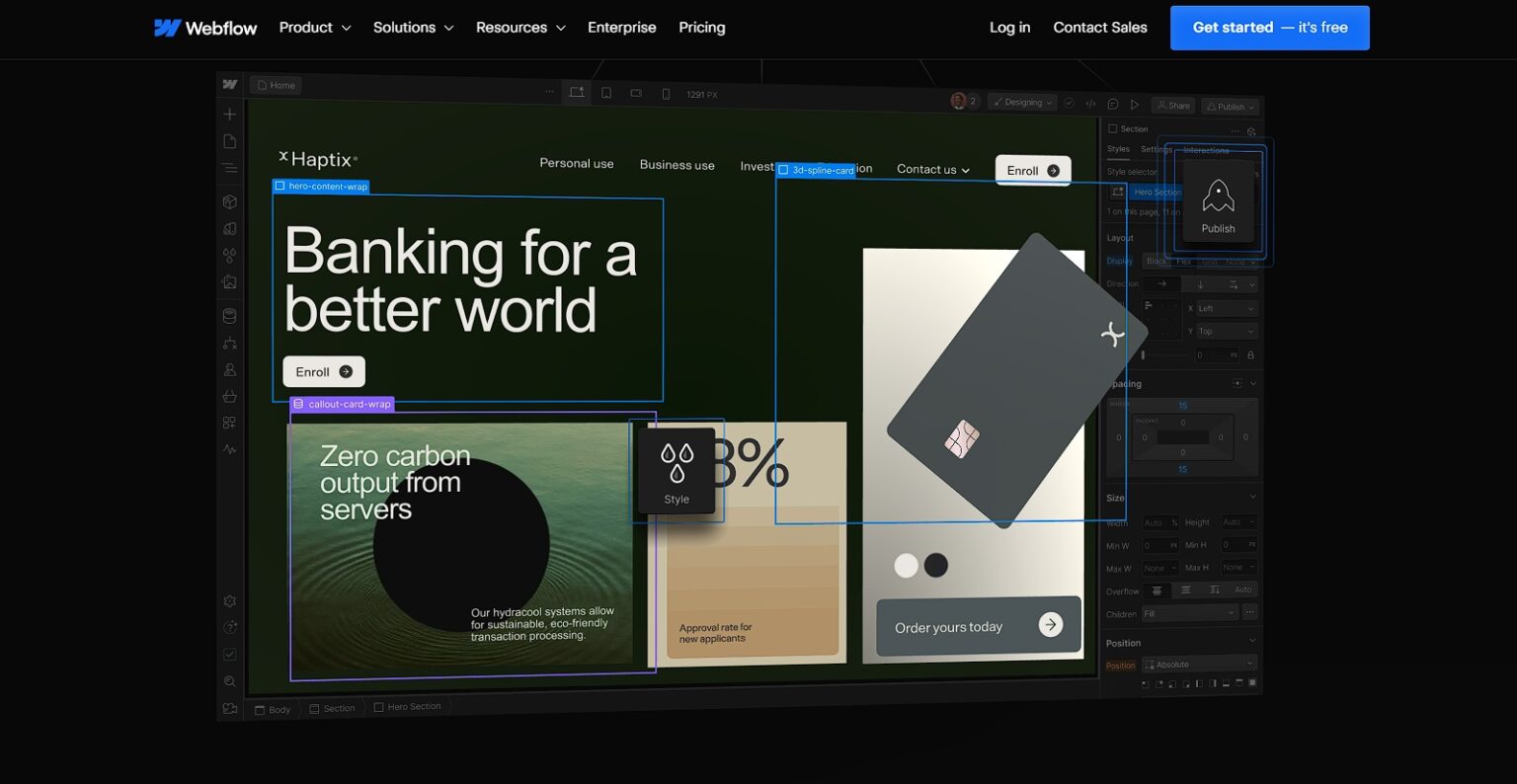Crafting a stunning and functional website requires the right instruments. In 2024, web design tools offer a wider range of options than ever before, catering to both beginners and seasoned professionals. Whether you prioritize drag-and-drop simplicity or code-driven customization, there’s a tool out there to streamline your workflow.
Here’s a look at 14 of the best web design tools you should consider in 2024:
1. Canva

Canva may not be the ultimate tool for complex web applications, but for crafting beautiful and functional websites, social media design, presentations, and more, it’s a user-friendly powerhouse that empowers beginners to create professional-looking designs.
Key Features
Here’s why it’s a superstar tool for beginners:
- Massive Template Library: Avoid the blank page blues! Canva offers a treasure trove of website templates across various industries and styles. Simply choose one that aligns with your vision and customize it to perfection.
- Drag-and-Drop Editing: Canva’s intuitive interface makes web design approachable for anyone. Drag and drop design elements like text boxes, images, and buttons exactly where you want them. No coding knowledge is required!
- Free Stock Media Library: Finding high-quality visuals can be a hurdle. Canva solves this by offering a vast library of free stock photos, illustrations, and videos. You can also upload your own media for a personalized touch.
- Collaboration Made Easy: Working with a team? Canva allows seamless collaboration. Share your design with colleagues, and they can edit and provide feedback in real time.
- Free vs. Paid Plans: Canva offers a generous free plan with access to millions of design elements. Upgrading to Canva Pro unlocks even more premium features like additional templates, fonts, and the ability to remove the background from images.
2. Wix
Wix is the embodiment of drag-and-drop ease. With Wix, you can create professional-looking websites without any coding knowledge. It offers a generous free plan and a plethora of features like SEO tools and analytics.
Key Features
Here’s a closer look at what makes it a popular choice for users of all experience levels:
- App Marketplace: Wix boasts a thriving app marketplace filled with free and paid extensions. Add functionalities like booking systems, online stores, email marketing tools, and more, all within the Wix interface.
- Wix ADI (Artificial Design Intelligence): Feeling overwhelmed by design choices? Wix ADI uses AI to analyze your preferences and create a customized website for you. It’s a fantastic time-saver for busy entrepreneurs.
- Business Solutions: Wix isn’t just about websites. It offers a suite of business tools like email marketing, customer management systems, and analytics.
While Wix prides itself on ease of use, it does have limitations. Users with coding knowledge might prefer a different platform for complete design freedom and customization. However, for those seeking a user-friendly solution to build professional-looking websites with e-commerce functionalities and built-in marketing tools, Wix remains a powerful contender.
3. Mobirise
This downloadable app allows you to create websites offline. Mobirise boasts a collection of website blocks and themes to jumpstart your project, making it a great option for crafting small business websites or landing page design.
Key Features
- Offline Functionality: Mobirise is a downloadable application, unlike many web design software. This means you can create websites entirely offline without an internet connection. It’s perfect for situations with unreliable internet access or for those who prefer the privacy of working offline.
- Drag-and-Drop Simplicity: Drag and drop pre-designed website blocks, like galleries, forms, and headers, to quickly build your website structure.
- Mobile-First Focus: Mobirise prioritizes mobile-responsive design. As mobile browsing continues to dominate, this ensures your website displays flawlessly on any device size.
However, Mobirise might not be ideal for complex web applications or those seeking complete design freedom. Since it’s an offline application, collaborating with a team on a project can be more challenging. Additionally, some users might find the design options less extensive compared to cloud-based web design tools for free.
4. Figma
A web-based design powerhouse, Figma offers collaborative design, prototyping, and developer handoff features, making it a favorite among design teams.
Key Features
Here’s a deeper dive into what makes Figma a standout choice for designers and design teams:
- Centralized Design System: Maintaining design consistency across a project can be challenging. Figma offers features like libraries and components that create a single source of truth for design elements, which helps with brand consistency and streamlines the design process.
- Prototyping Tools: Transform static designs into interactive prototypes with Figma’s robust prototyping features. You can test user flows, and user interactions, and get valuable feedback before development begins.
- Developer Handoff: The handoff process between designers and developers can be a bottleneck. Figma bridges this gap by generating clean code snippets and asset exports.
5. Sketch

For Mac users, Sketch remains a go-to choice for UI/UX design and wireframing. So, a crucial point for Windows users is that Sketch is exclusive to Mac computers. While not web-based, Sketch excels at user interface (UI) and user experience (UX) design. Its vector editing tools, symbol libraries, and prototyping features make it a designer favorite.
Key Features
- Plugin Paradise: A vast plugin ecosystem extends Sketch’s functionality with features like data import, accessibility checkers, and code generation.
- Version Control Integration: Unlike some competitors, Sketch integrates seamlessly with version control systems like Git, allowing for efficient project management and collaboration (though often with additional plugins).
6. Adobe XD
Part of the Adobe suite, XD caters to designers familiar with Adobe products. It offers a sleek interface, strong prototyping tools, and integrates well with other Adobe applications.
Key Features
- Seamless Integration with Adobe Creative Suite: If you’re already invested in Adobe products like Photoshop and Illustrator, XD offers a familiar interface and smooth integration. Assets like images and icons can be easily transferred between applications.
- Robust Prototyping Features: XD goes beyond static mockups by allowing creating interactive prototypes with transitions, micro-interactions, and even voice commands.
- Developer-Friendly Handoff: XD generates clean code snippets, exportable assets, and developer-friendly documentation.
7. Marvel
An excellent tool for beginners in prototyping, Marvel lets you create interactive prototypes from your existing design files. It streamlines the feedback process and is perfect for user testing.
Key Features
- Prototyping Made Easy: Marvel shines in its simplicity and focus on prototyping. Upload your existing design files from Sketch, Photoshop, or Figma, and quickly create interactive prototypes for user testing and feedback.
- Perfect for Beginners: With its intuitive interface and focus on a specific task (prototyping), Marvel is a great entry point for those new to web design and development services.
- Feedback Loop: Marvel streamlines the feedback process by allowing stakeholders to leave comments directly on prototypes, facilitating communication and iteration.
8. WordPress
The world’s most popular content management system (CMS), WordPress excels at creating blogs and websites. Thousands of themes and plugins extend its functionality, making it highly versatile.
Key Features
- Unmatched Ease of Use: WordPress boasts an intuitive interface that doesn’t require coding knowledge. Creating and managing content, like blog posts and pages, is as simple as using a word processor.
- Flexibility for All: Whether you’re crafting a personal blog, a complex business website, or an online store, WordPress adapts to your needs. Thousands of themes and plugins extend its functionality, allowing you to build virtually any type of website imaginable.
- SEO Friendly: Out of the box, WordPress is built with search engine optimization (SEO) in mind. This means your website has a higher chance of ranking well in search results, driving organic traffic.
9. Webflow

Webflow bridges the gap between web design and development services. You can design and build websites visually without writing code. However, some coding knowledge can unlock its full potential.
Key Features
- Visual Design Canvas: Unlike traditional coding, Webflow allows you to design websites visually. Drag and drop elements, style typography, and arrange layouts, all within a user-friendly interface.
- Clean Code Generation: Behind the scenes, Webflow generates clean, well-structured code. This means you can export your website and have full control over the code if needed, unlike some drag-and-drop builders.
- CMS Integration: Webflow integrates a built-in content management system (CMS), allowing you to easily manage website content like blog posts, pages, and product listings.
- Client Handoff: Webflow simplifies the handoff process for developers. Clean code and the ability to export projects make it easy for developers to take over if needed.
10. Visual Studio Code
A free, open-source code editor, VS Code is a developer favorite. It supports a wide range of programming languages and offers features like syntax highlighting and debugging tools. But this tool offers more and is recognized as a developer’s favorite tool for a reason.
Here’s why:
- Cross-Platform Compatibility: VS Code runs seamlessly on Windows, macOS, and Linux. This allows developers to work on their preferred operating system without limitations.
- Lightweight and Efficient: It opens quickly, doesn’t hog system resources, and provides a smooth development experience.
- Extensive Customization: VS Code offers a high level of customization. Themes, extensions, and keyboard shortcuts can be tailored to your workflow preferences.
11. Bootstrap
A popular front-end framework, Bootstrap helps developers quickly build responsive websites with pre-built components like buttons, forms, and navigation menus.
Key Features
- Pre-Built Components: Bootstrap offers a library of pre-built components like buttons, forms, navigation bars, and more. These components are styled and responsive, ensuring a consistent look and feel across devices.
- Faster Development: By leveraging pre-built components and pre-written CSS code, Bootstrap allows developers to build websites faster. This saves them time and effort compared to coding everything from scratch.
- Mobile-First Approach: Bootstrap is built with mobile-first principles. This means websites built with Bootstrap automatically adapt to different screen sizes.
12. Framer
While Figma and Sketch dominate the design scene, other tools cater to specific needs. An advanced prototyping tool, Framer is a major tool useful for complex interactions and animations. It’s ideal for designers and developers working on cutting-edge web experiences.
Key Features
- Advanced Prototyping Powerhouse: Framer goes beyond basic prototyping. It allows creating complex interactions, animations, and even functional components, making it ideal for designing highly interactive web experiences.
- Developer-Friendly Handoff: Framer generates clean code snippets and interactive prototypes that developers can easily understand and implement.
- Design for the Future: Framer embraces cutting-edge web technologies like WebGL and WebAssembly. This allows designers to create prototypes that feel closer to real-world applications.
13. GIMP
Next is one of the best free web website programs: GIMP. GIMP offers a powerful alternative to expensive web page design software like Photoshop. It’s great for photo editing and creating basic web graphics.
Key Features
- Extensive Features: GIMP offers a surprising range of features for photo editing, graphic design, and image manipulation. From basic adjustments to advanced filters and retouching tools, it caters to various image editing needs.
- Customization Options: GIMP allows extensive customization through plugins and scripts. This vast ecosystem extends functionality and caters to specific workflows.
14. Vectr
Another best free web design tool, Vectr lets you create vector graphics for your website. It’s a user-friendly option for beginners who don’t require the full feature set of paid software.
Key Features
- Free Vector Graphics Editor: Vectr is one of the best free website tools for creating vector graphics. This makes it a great option for beginners or those who don’t require the advanced features of paid vector design software like Adobe Illustrator.
- Simple Interface: Vectr boasts a clean and intuitive interface that’s easy to learn, even for those new to graphic design.
- Real-Time Collaboration: Similar to Figma, Vectr allows real-time collaboration on designs. This is a valuable feature for teams working on projects together.
Wrap Up
This article has explored just a fraction of the top website design tools available. Remember, the best tool empowers you to create, and the readily available learning resources can help you master any platform you choose.
Many of these tools offer free trials or plans, allowing you to test-drive their functionalities before committing. With a bit of exploration and practice, you’ll be well on your way to crafting stunning and functional websites that leave a lasting impression.
Are you too busy to deal with these tools? If you want the best design for your business website, let our digital marketing agency do it for you! Our team of UI and UX designers will deliver stunning designs that will captivate your target customers!



